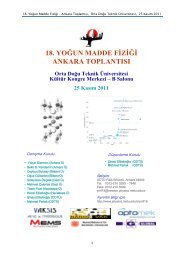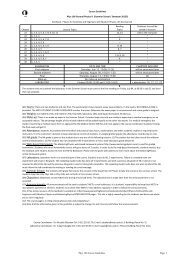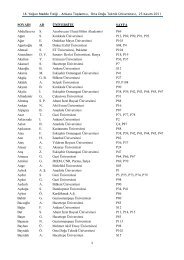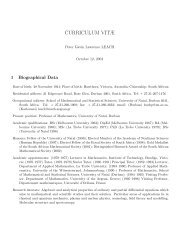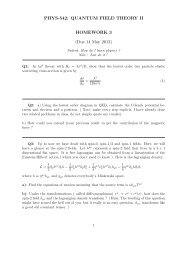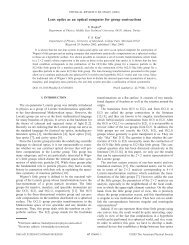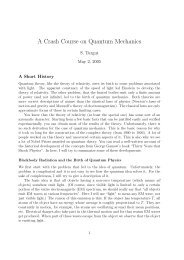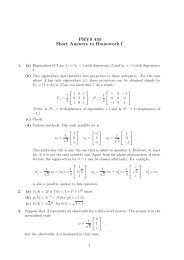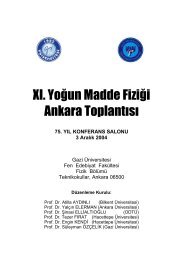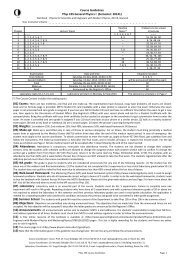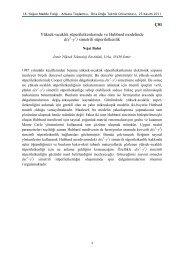SExtractor Draft - METU Astrophysics
SExtractor Draft - METU Astrophysics
SExtractor Draft - METU Astrophysics
- No tags were found...
Create successful ePaper yourself
Turn your PDF publications into a flip-book with our unique Google optimized e-Paper software.
22are generally useless, except perhaps for images having an unusually high dynamic range. Incase of memory problems, decreasing the number of thresholds to say, 8 or even less may bea solution. But then of course a degradation of the deblending performances may occur. Thesecond parameter is the contrast parameter (DEBLEND MINCONT). As described above, valuesfrom 0.001 to 0.01 give best results. Putting DEBLEND MINCONT to 0 means that even the faintestlocal peaks in the profile will be considered as separate objects. Putting it to 1 means thatno deblending will be authorized. The last parameter concerns the kind of scale used for thethresholds. If the image comes from photographic material, then a linear scale has to be used(DETECTION TYPE = PHOTO). Otherwise, for an image obtained with a linear device like a CCD,an exponential scale is more appropriate (DETECTION TYPE = CCD).7 WeightingThe noise level in astronomical images is often fairly constant, that is, constant values for thegain, the background noise and the detection thresholds can be used over the whole frame.Unfortunately in some cases, like strongly vignetted or composited images, this approximationis no longer good enough. This leads to detecting clusters of detected noise peaks in the noisiestparts of the image, or missing obvious objects in the most sensitive ones. <strong>SExtractor</strong> is ableto handle images with variable noise. It does it through weight maps, which are frames havingthe same size as the images where objects are detected or measured, and which describe thenoise intensity at each pixel. These maps are internally stored in units of absolute variance (inADU 2 ). We employ the generic term “weight map” because these maps can also be interpretedas quality index maps: infinite variance (≥ 10 30 by definition in <strong>SExtractor</strong>) means that therelated pixel in the science frame is totally unreliable and should be ignored. The varianceformat was adopted as it linearizes most of the operations done over weight maps (see below).This means that the noise covariances between pixels are ignored. Although raw CCD imageshave essentially white noise, this is not the case for co-added images, for which resampling mayinduce a strong correlation between neighbouring pixels. In theory, all non-zero covarianceswithin the geometrical limits of the analysed patterns should be taken into account to derivethresholds or error estimates. Fortunately, the correlation length of the noise is often smallerthan the patterns to be detected or measured, and constant over the image. In that case onecan apply a simple “fudge factor” to the estimated variance to account for correlations onsmall scales. This proves to be a good approximation in general, although it certainly leads tounderestimations for the smallest patterns.7.1 Weight-map formats<strong>SExtractor</strong> accepts in input, and converts to its internal variance format, several types of weightmaps.This is controlled through the WEIGHT TYPE configuration keyword. These weight-mapscan either be read from a FITS file, whose name is specified by the WEIGHT IMAGE keyword, orcomputed internally. Valid WEIGHT TYPEs are:• NONE: No weighting is applied. The related WEIGHT IMAGE and WEIGHT THRESH (see below)parameters are ignored.• BACKGROUND: the science image itself is used to compute internally a variance map (therelated WEIGHT IMAGE parameter is ignored). Robust (3σ-clipped) variance estimates are



